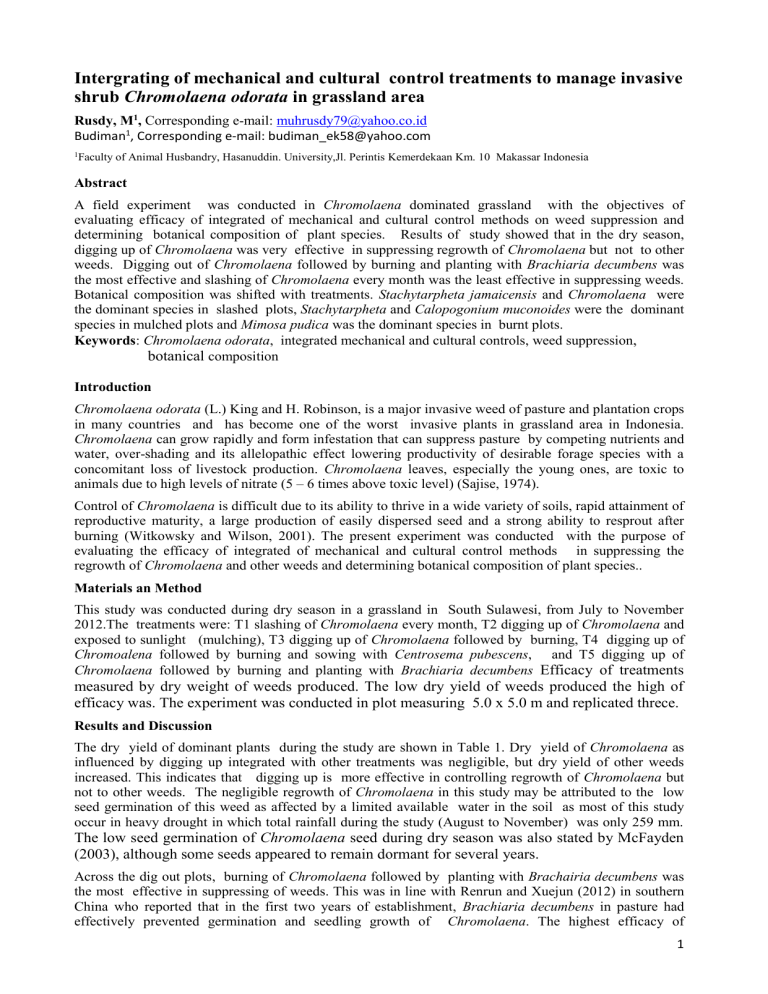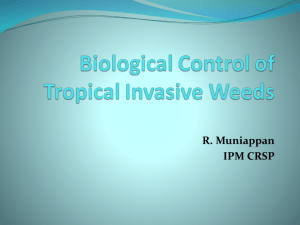Running Title: Mechanical and Cultural Control of Chromolaena

Intergrating of mechanical and cultural control treatments to manage invasive shrub Chromolaena odorata in grassland area
Rusdy, M 1 , Corresponding e-mail: muhrusdy79@yahoo.co.id
Budiman 1 , Corresponding e-mail: budiman_ek58@yahoo.com
1 Faculty of Animal Husbandry, Hasanuddin. University,Jl. Perintis Kemerdekaan Km. 10 Makassar Indonesia
Abstract
A field experiment was conducted in Chromolaena dominated grassland with the objectives of evaluating efficacy of integrated of mechanical and cultural control methods on weed suppression and determining botanical composition of plant species. Results of study showed that in the dry season, digging up of Chromolaena was very effective in suppressing regrowth of Chromolaena but not to other weeds. Digging out of Chromolaena followed by burning and planting with Brachiaria decumbens was the most effective and slashing of Chromolaena every month was the least effective in suppressing weeds.
Botanical composition was shifted with treatments. Stachytarpheta jamaicensis and Chromolaena were the dominant species in slashed plots, Stachytarpheta and Calopogonium muconoides were the dominant species in mulched plots and Mimosa pudica was the dominant species in burnt plots.
Keywords : Chromolaena odorata , integrated mechanical and cultural controls, weed suppression
,
botanical
composition
Introduction
Chromolaena odorata (L.) King and H. Robinson, is a major invasive weed of pasture and plantation crops in many countries and has become one of the worst invasive plants in grassland area in Indonesia.
Chromolaena can grow rapidly and form infestation that can suppress pasture by competing nutrients and water, over-shading and its allelopathic effect lowering productivity of desirable forage species with a concomitant loss of livestock production. Chromolaena leaves, especially the young ones, are toxic to animals due to high levels of nitrate (5 – 6 times above toxic level) (Sajise, 1974).
Control of Chromolaena is difficult due to its ability to thrive in a wide variety of soils, rapid attainment of reproductive maturity, a large production of easily dispersed seed and a strong ability to resprout after burning (Witkowsky and Wilson, 2001). The present experiment was conducted with the purpose of evaluating the efficacy of integrated of mechanical and cultural control methods in suppressing the regrowth of Chromolaena and other weeds and determining botanical composition of plant species..
Materials an Method
This study was conducted during dry season in a grassland in South Sulawesi, from July to November
2012.The treatments were: T1 slashing of Chromolaena every month, T2 digging up of Chromolaena and exposed to sunlight (mulching), T3 digging up of Chromolaena followed by burning, T4 digging up of
Chromoalena followed by burning and sowing with Centrosema pubescens , and T5 digging up of
Chromolaena followed by burning and planting with Brachiaria decumbens
Efficacy of treatments measured by dry weight of weeds produced. The low dry yield of weeds produced the high of efficacy was. The experiment was conducted in plot measuring 5.0 x 5.0 m and replicated threce.
Results and Discussion
The dry yield of dominant plants during the study are shown in Table 1. Dry yield of Chromolaena as influenced by digging up integrated with other treatments was negligible, but dry yield of other weeds increased. This indicates that digging up is more effective in controlling regrowth of Chromolaena but not to other weeds. The negligible regrowth of Chromolaena in this study may be attributed to the low seed germination of this weed as affected by a limited available water in the soil as most of this study occur in heavy drought in which total rainfall during the study (August to November) was only 259 mm.
The low seed germination of Chromolaena seed during dry season was also stated by McFayden
(2003), although some seeds appeared to remain dormant for several years.
Across the dig out plots, burning of Chromolaena followed by planting with Brachairia decumbens was the most effective in suppressing of weeds. This was in line with Renrun and Xuejun (2012) in southern
China who reported that in the first two years of establishment, Brachiaria decumbens in pasture had effectively prevented germination and seedling growth of Chromolaena . The highest efficacy of
1
Brachiaria may be attributed to vigorous nature of Brachiaria growth and its ability to extract growth resources from the soil.
Botanical compositions of species was shifted with treatments In monthly slashed plots the dominant plants were Chromolaena and Stahytarpheta jamaicensis and in mulched plots, the dominant species were
Calopogonium muconoides and Stachytarpheta . In burnt plot, the dominant species was taken over by
Mimosa pudica . The high botanical composition of Mimosa in burnt plot indicating that burning stimulated germination and seedling growth of this plant. This is in line with reports of De Menezes and
Rossi (2011) that burning of Mimosa seeds can kill surface seeds but not buried seeds and may stimulate seeds germination due to removal of seed coat. In contrast, in this study the botanical composition of
Stachytarpheta in burnt plots was lower compared to that of unburnt plots. This may be attributed to killing much of Sachytarpheta seeds by burning as its seed germination and emergence were restricted to seeds planted at the soil surface that easily killed by burning (Diaz-Filho,1996).
Conclusion
From this study, it can be concluded that digging out of Chromolaena , followed by burning and planting with Brachiaria decumbens is the most promising method to control this weed in grassland area. It needs further study how this grass can control this weed in the rainy season and how to manage this grass in order to get a high a animal production while continuing to control this weed.
Acknowlwdgement
The authors are thankful to Rector of Hasanuddin University for providing financial support and Dean of
Faculty of Animal Husbandry for permitting us to use Maiwa ranch as a site to carry out this experiment.
We also would to thank to the local people for assisting the field study.
References
De Menezes LCCR and Rossi MN (2011) A study with plant inhabiting non-fire prone areas. Phyton.Int. J. Exp.
Botany, 80 : 153 – 160.
Diaz-Filho MB (1996) Germination and emergence of Stachytarpheta cayennensis and Ipomoea asarifolia. Planta
Daninha, 14 (2): 118- 126.
McFayden, R 2003.
Chromolaena odorata in South East Asia and Pacific. Aust. J. Entomol: 42 : 130 – 134.
Renrun W Xaejun X (2012). Cultural control of Fejicao ( Chromolaena odorata (L.) R.M. King and H. Robinson
by planting signal grass ( Brachiaria decumbens Stapf) in Southern Yunnan,The People’s Republic of China. http://www . ehs.cdu.edu.au/chromolaena /proceedings/second/cultural control of Fejicao. Accessed on November
12, 2012
Sajise PE Palls PK Norcio NV Lales JS (1974). Flowering behavior, pattern of growth, and nitrate metabolism in
Chromolaena odorata . Phil. Weed Sci. Bull. 1 : 17 – 24.
Witkowsky ETF Wilson M (2001). Changes in density, biomass seed production and seed soil bank of non native plant Chromolaena odorata along 15 years chronosequence. Plant Ecology: 152 (1): 13 – 27.
Table 1. The rank of dominant species based on dry matter yield (g/plot) (in parenthesis) every month after
treatment
______________________________________________________________________________
Month after treatment
Treatment ---------------------------------------------------------------------------------------------------------------
One Two Three
-----------------------------------------------------------------------------------------------------------------------------
T1 Chromolaena (353.33) Stachytarpheta (1983.35) Stachytarpheta (1650.00)
Stachytarpheta (345.00) Chromolaena (1370.00) Borreria sp (441.65)
Total weeds (1081.65) Total weeds (6236.65) Total weeds (3095.02)
T2 Calopogonium (790.00) Stachytarpheta (1451.65) Stachytarpheta (1365.35)
Stachytarpheta (145.00) Calopogonium (740.00) Calopogonium (740.00)
Total weeds (281.65) Total weeds (2261.65) Total weeds (1949.5)
T3 Mimosa (281.35) Mimosa (1803.35) Mimosa (1420.00)
Stachytarpheta (180.00) Stachytarpheta (561.33) Stachytarpheta (396.65)
Total weeds (550.00) Total weeds (3195.00) Total weeds (2865.00)
T4 Mimosa (286.65) Mimosa (1803.35) Mimosa (1416.65)
Centrosema (215.00) Centrosema (875.00) Centrosema (395.00)
2
Total weeds (555.00) Total weeds (4531.65) Total weeds (2176.20)
T5 Brachiaria (443.35) Brachiaria (3256.65) Brachiaria (4916.65)
Mimosa (148.35) Mimosa (328.35) Mimosa (493.35)
Total weeds (308.33) Total weeds (836.67) Total weeds (1065.00)
----------------------------------------------------------------------------------------------------------------------------
3







